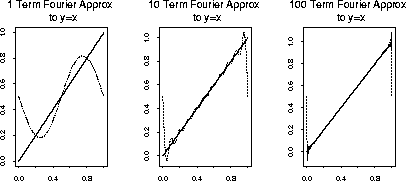STAT 804: Lecture 20 Notes
Properties of Fourier Series
The Fourier series for a function f truncated to order K, namely
![]()
where the coefficients are given by the Fourier integrals gives the best
possible approximation to f as a linear combination of these sines
and cosines in the following sense.
Suppose we try to choose ![]() and
and ![]() to minimize
to minimize
![]()
where
![]()
Squaring out the integrand and integrating term by term we get, remembering that the sines and cosines are orthogonal,

Taking a derivative with respect to, say, ![]() gives
gives
![]() which is 0 when
which is 0 when ![]() is the Fourier coefficient.
is the Fourier coefficient.
This result says that a Fourier series is the best possible approximation to a function f by a trigonometric polynomial of this type. However, the conclusion depends quite heavily on how we measure the quality of approximation. Below are Fourier approximations to each of 3 functions on [0,1]: the line y=x, the quadratic y=x(1-x) and the square well y=1(x;SPMlt;0.25)+1(y;SPMgt;0.75). For each plot the pictures get better as K improves. However the well shaped plot shows effects of Gibb's phenomenon: near the discontinuity in f there is an overshoot which is very narrow and spiky. The overshoot is of a size which does not depend on the order of approximation.
A simliar discontinuity is implicit in the function y=x since the Fourier approximations are periodic with period 1. This means that the approximations are equal at 0 and at 1 while y=x is not. The quadratic function does have f(0)=f(1) and the Fourier approximation is much better.
My Splus plotting code:
lin <- function(k)
{
x <- seq(0, 1, length = 5000)
kv <- 1:k
sv <- sin(2 * pi * outer(x, kv))
y <- - sv %*% (1/(pi * kv)) + 0.5
plot(x, x, xlab = "", ylab = "", main = paste(as.character(k),
"Term Fourier Approximation to y=x"), type = "l")
lines(x, y, lty = 2)
}
shows the use of the outer function and the paste function as well as
how to avoid loops using matrix arithmetic.


